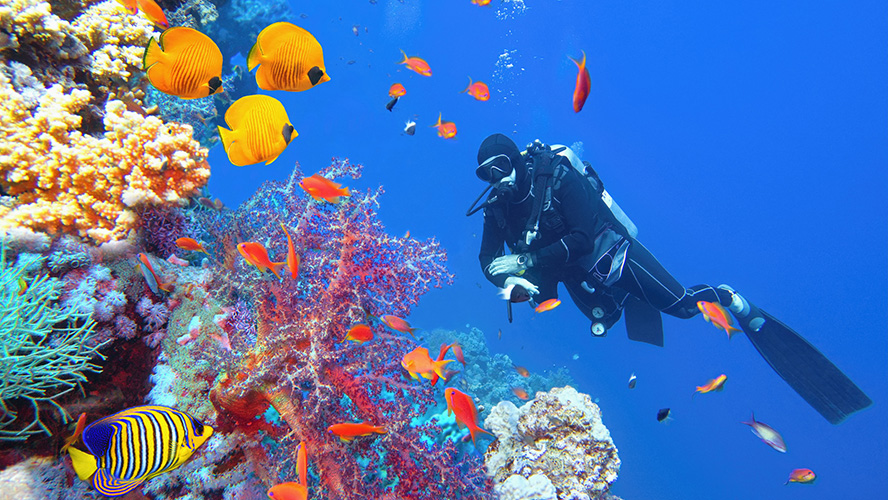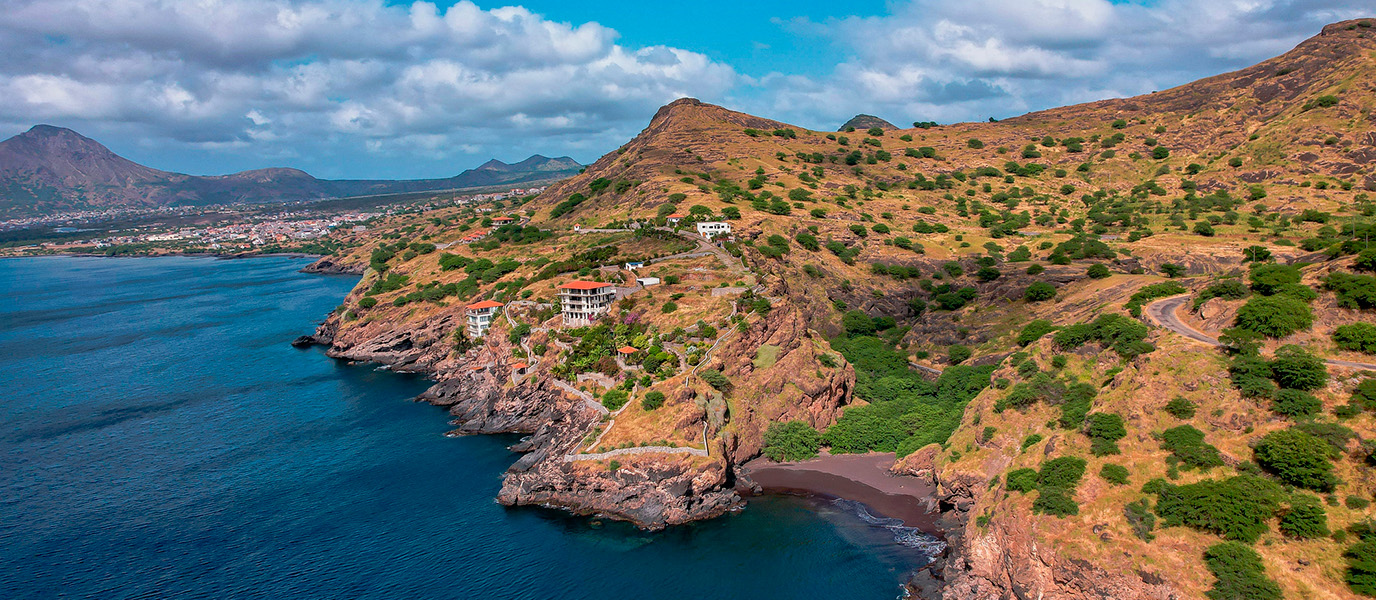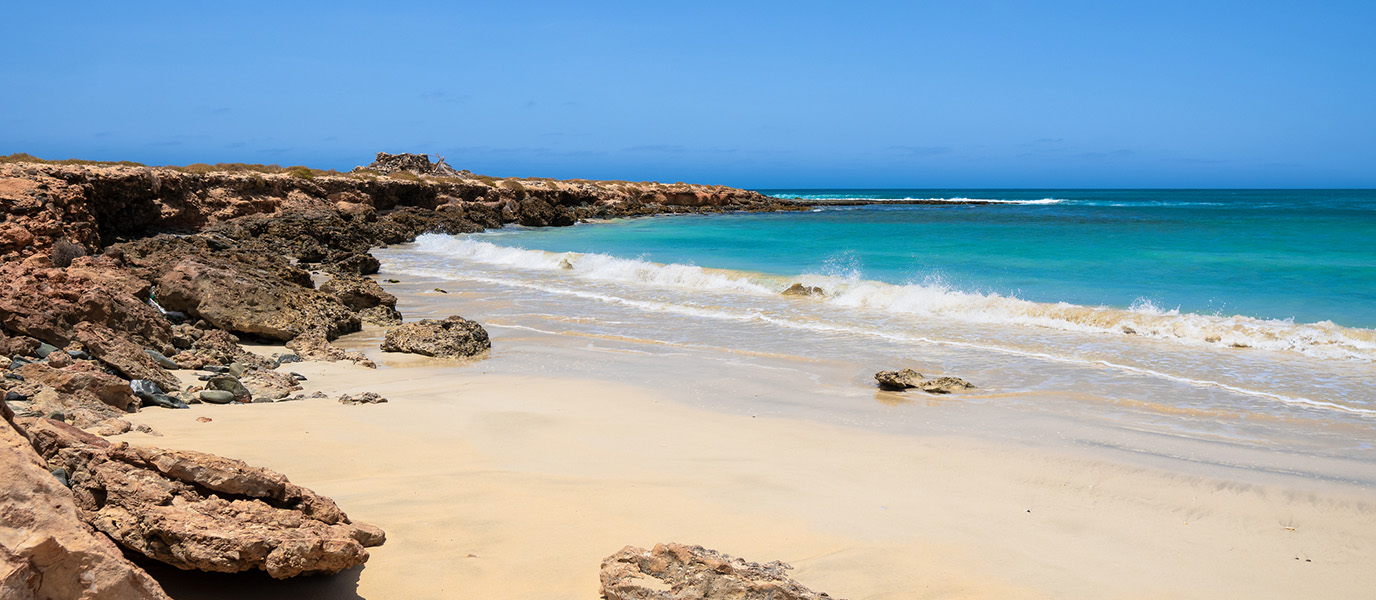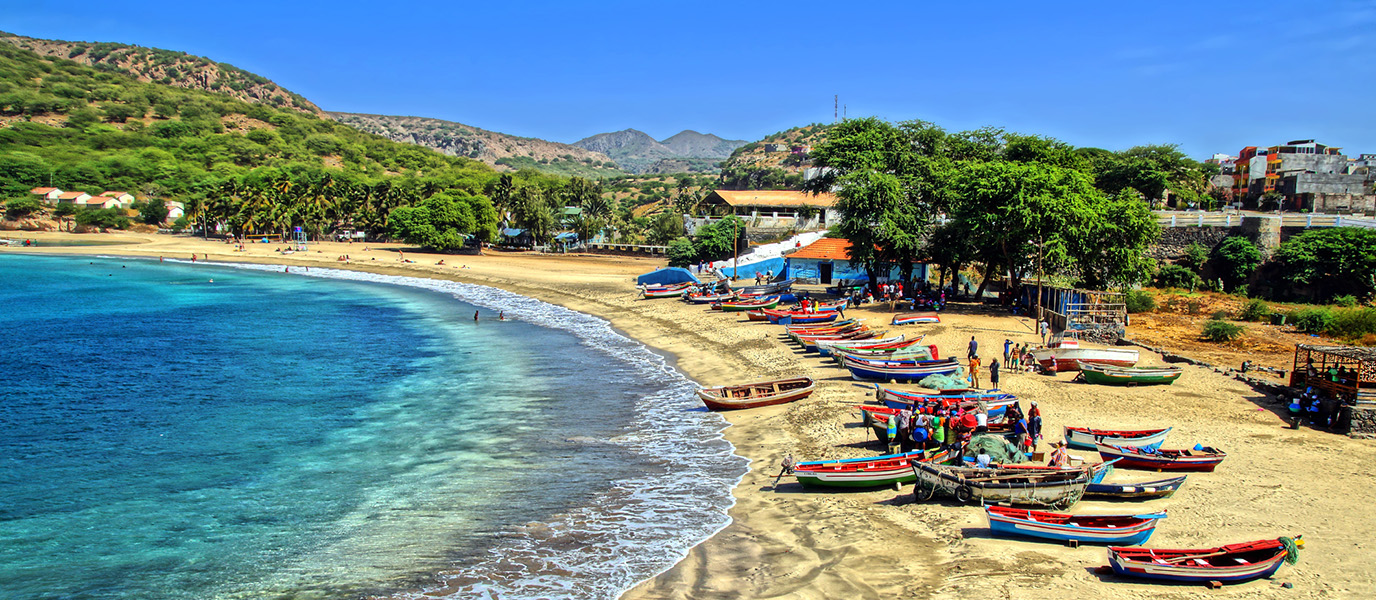To travel to Cape Verde (an archipelago of ten volcanic islands lost in the middle of the Atlantic Ocean, around 600 kilometres from Senegal) is to be transported to a different universe. This up-and-coming destination, considered to be Africa’s most democratic country and frequently compared with the Canary Islands, blends its African, European and Brazilian heritages in a unique way, in an awe-inspiring setting of volcanic landscapes, idyllic beaches, and a rich Creole culture. Each island has something different to offer, from the hustle and bustle of the capital Praia to the dramatic volcanic scenery of Pico do Fogo, to the lively, music-filled cities such as Mindelo. If you are looking for somewhere full of contrasts offering adventure, relaxation and the chance to explore a unique culture and history, Cape Verde is the perfect destination for you.
Praia: an African capital city full of contrasts
Praia, the capital of Cape Verde, lies on the island of Santiago; with almost 160,000 inhabitants, it is the economic and cultural heart of the country. Straight away, one can see that Praia combines its Portuguese colonial spirit with a modern touch, as its cobbled streets are lined with modern buildings. The old city, known as Plateau and standing on a promontory with views of the Atlantic Ocean, is the historic epicentre, where visitors can stroll along Avenida 5 de Julho and around charming squares such as Plaza Alexandre Albuquerque, surrounded by brightly coloured colonial buildings.
Praia’s greatest attractions include the Church of Nossa Senhora da Graça, built in a neo-Classical style in the nineteenth century, and the Ethnographic Museum, which offers a fascinating perspective on the history of the islands and their Creole culture. Nor should visitors miss the Monument of Diogo Gomes, the Portuguese sailor who discovered the island of Santiago in 1460. If you want to see the most authentic side of Cape Verde, do not miss Sucupira market, a seething hub of local life where you can find everything from craft items to traditional clothing and food. The capital city also has a few local beaches such as Praia de Gamboa, perfect for relaxing after a day’s sightseeing.
Pico do Fogo, the magnificence of an active volcano
Pico do Fogo, on the island of Fogo, is one of Cape Verde’s most emblematic sights and the highest point on the archipelago. Rising to a height of 2,829 metres, this volcano is the island’s greatest natural attraction, and an essential visit for lovers of nature and of hiking.
The climb up to the crater is quite a challenge for visitors, but the views from the summit are ample reward — breathtaking scenery stretching as far as the Atlantic Ocean. The most recent eruption occurred in 2014 and, as you climb, you can see the fields of solidified lava showing the immense power of nature. The Chã das Caldeiras area is made up of two towns that lie at the base of the volcano, Potela and Bangaira (the latter was buried by the 2014 eruption), and is a testimony to the resilience of those who live in the foothills of this huge volcano, as well as the perfect place to try Fogo’s famous wine.
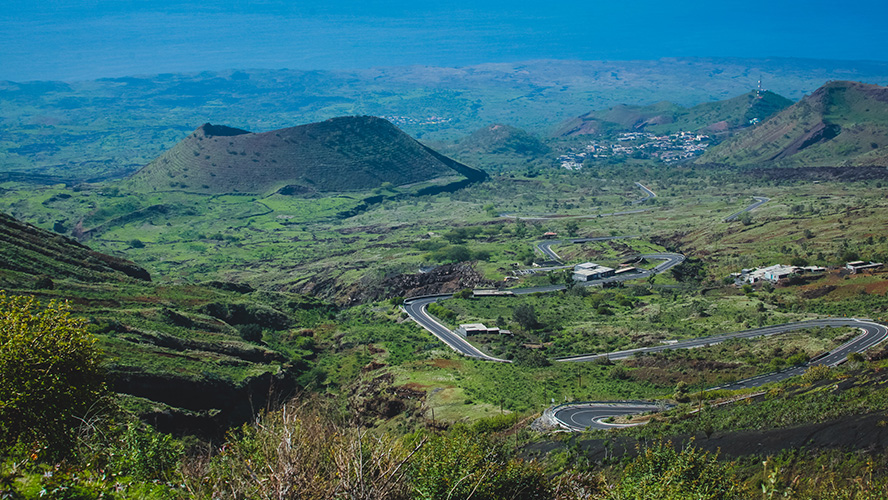
Mindelo, the musical soul of Cape Verde
The city of Mindelo, on the island of São Vicente, is regarded as the cultural capital of Cape Verde. This is a city that exudes music from every pore, particularly traditional genres such as the Morna, the Coladeira and the Funaná; it was the home of the renowned singer Cesária Évora, who brought Cape Verde on to the world stage.
Strolling though the streets of Mindelo is an experience in itself, with its colonial architecture and buzzing atmosphere that encourages visitors to enjoy its nightlife and its bars offering live music. The city’s star attraction is the Bay of Porto Grande, where the port is located with its colourful fishing boats moored next to the Mercado do Peixe (Fish Market). And make sure you don’t miss the Café Royal, the only one of the cafés where the famous Cape Verde artist sang that is still standing; the lively Municipal Market or the Palacio del Pueblo, the former residence of the Governor and now a museum dedicated to Cesária Évora — all vestiges of the city’s colonial history. If you visit Mindelo during Carnival season, you will witness one of the most colourful and vibrant celebrations in the whole of West Africa.
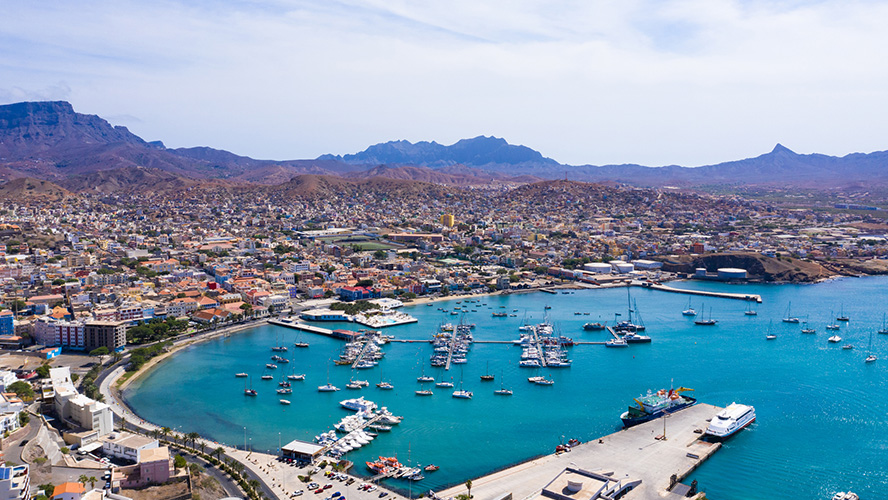
Cidade Velha, the history of Cape Verde written in stone
Cidade Velha, on the island of Santiago, was the first European city to be established in the tropics, and is a UNESCO World Heritage Site. Founded in 1462, it is the best place to learn about the colonial history of Cape Verde, which was an important point on the slave trade routes.
Its main attractions include the Royal Fortress of São Filipe, built during the sixteenth century in honour of Philip II of Spain (and also King of Portugal at that time), and affording impressive views of the ocean and of the surrounding mountains — along with Rua Banana, a cobbled street which is said to be the oldest in Africa. Here, too, you can visit the ruins of the Church of Nossa Senhora do Rosário; built in 1495, it is the oldest colonial church in the world and one of the oldest on the continent, reflecting the country’s religious and cultural history. Cidade Velha is a living testament to the blend of African and European cultures.
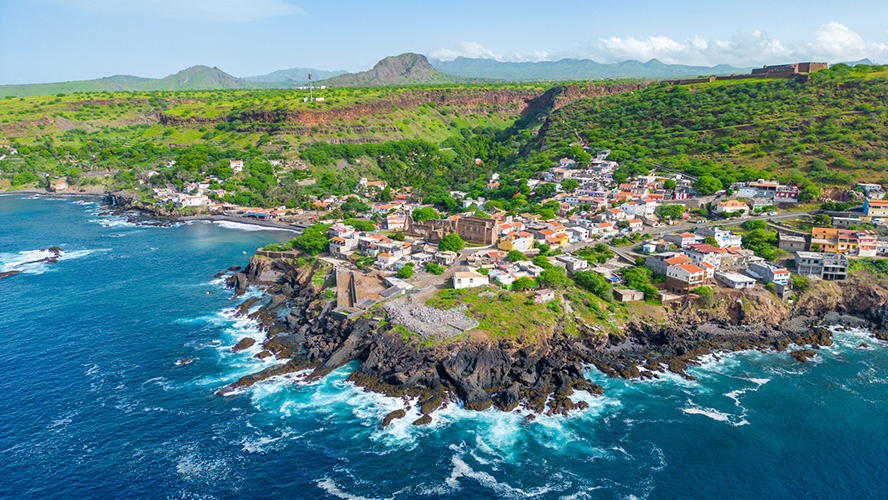
Island of Boa Vista: dunes, desert and endless beaches
The island of Boa Vista is famous for its endless beaches of white sand, its dunes, and its calm atmosphere. It is the ideal spot for those seeking to disconnect and relax. One of the best-known beaches is Praia de Santa Mónica with over 20 kilometres of fine sand and turquoise waters, offering a virtually pristine sight.
Boa Vista is also home to sea turtles, and if you visit the island between July and October, you will have the opportunity to see these magnificent creatures spawn on the beach. Don’t forget to visit the Viana Desert, a small desert formed by sands blown by the wind from the Sahara. The quad or 4×4 excursions available in this area are an unforgettable experience.
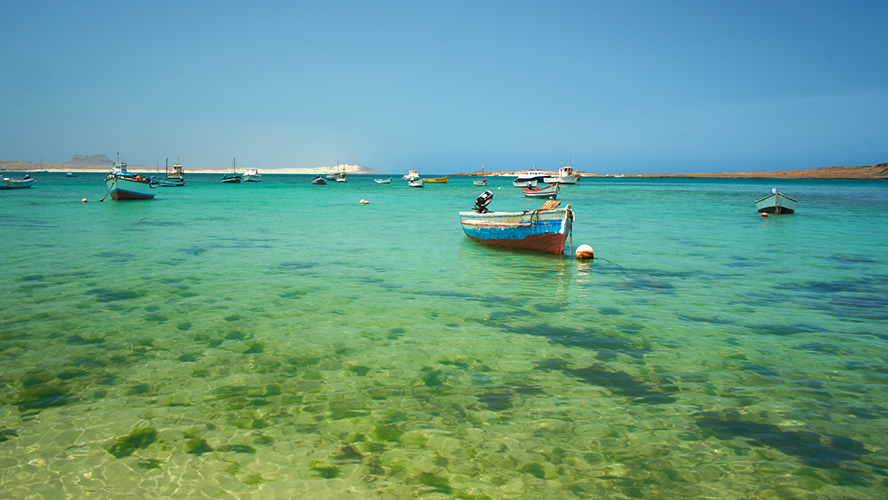
The island of São Vicente, culture and volcanic scenery in harmony
São Vicente is a mixture of contrasts between the city life of Mindelo and the wilder, natural world of the surrounding area. Beyond Mindelo, the cultural heart of Cape Verde and home to 90% of the population of São Vicente, the island offers remote volcanic landscapes that combine mountains, beaches, and small towns that retain their traditional character. Monte Verde, which lies in the natural park of the same name, is the island’s highest peak, and offers striking views of the surrounding islands. Climbing to the summit is a popular activity with hikers and nature lovers.
The coast around São Vicente is also famous for its beaches of volcanic sand, such as Praia da Laginha, an idyllic spot to relax or enjoy water sports. The beach of São Pedro is famous for its turtles which you can see swimming near the shore; the locals will take you to see them in their boats for a modest fee, and you can swim with them. From here, you could also enjoy a beautiful, 6-kilometre walk to the Doña Amélia lighthouse.
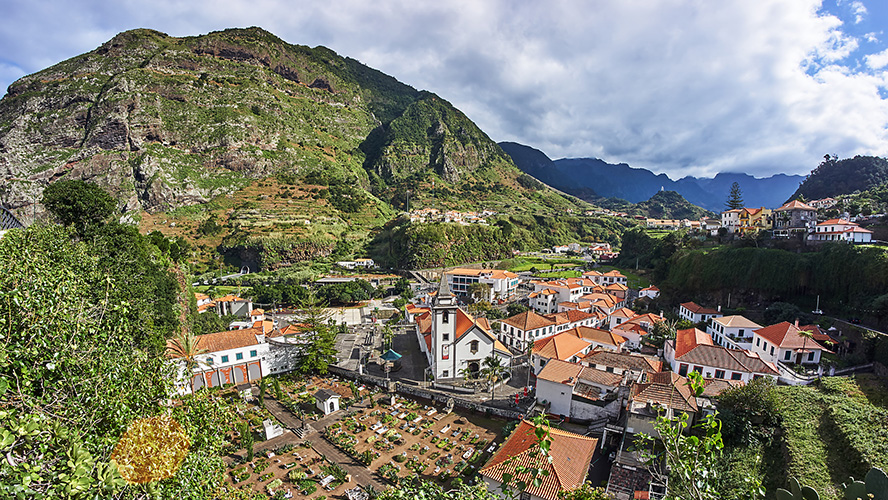
The Island of Santiago, the soul of Cape Verde
The island of Santiago, the largest and most populated island in the archipelago, is the political and financial centre of Cape Verde. This is an essential visit, as it is the most diverse island in the archipelago. Here, you will find a range of scenery from steep mountains to fertile valleys, idyllic beaches, and an arid terrain that resembles that of Mars. Praia, the capital, is the point of departure, but the true jewel of Santiago is its small towns and rural areas, where the farming culture lives on.
The Serra Malagueta Natural Park is heaven on Earth for hiking enthusiasts, with trails that offer impressive views of the ocean and of the lush vegetation. Tarrafal, on the northern coast, is known for its beach of white sand — and for its dark past as a political prison during the Portuguese dictatorship.
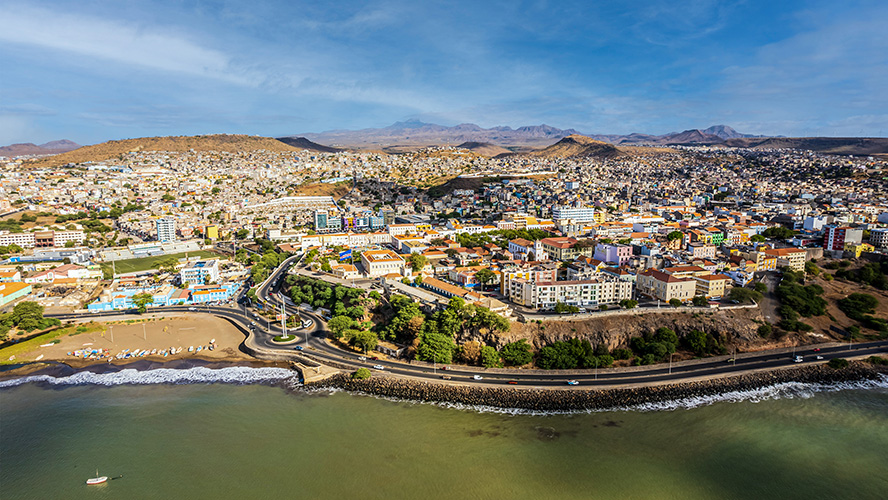
The best beaches: too many to choose from
Cape Verde is a paradise for beach lovers, and on each of the islands you can find a unique spot to enjoy the sun and the sea. Among the most outstanding beaches are Praia de Santa Mónica on Boa Vista, famous for its great length and tranquility, and Praia de Chaves, also on Boa Vista, which is perfect for water sports.
On the island of Sal, Praia de Ponta Preta is popular with surfers and kitesurfers thanks to its strong winds, while Praia de Laginha on São Vicente is ideal for those who prefer calmer waters and a more urban ambience.
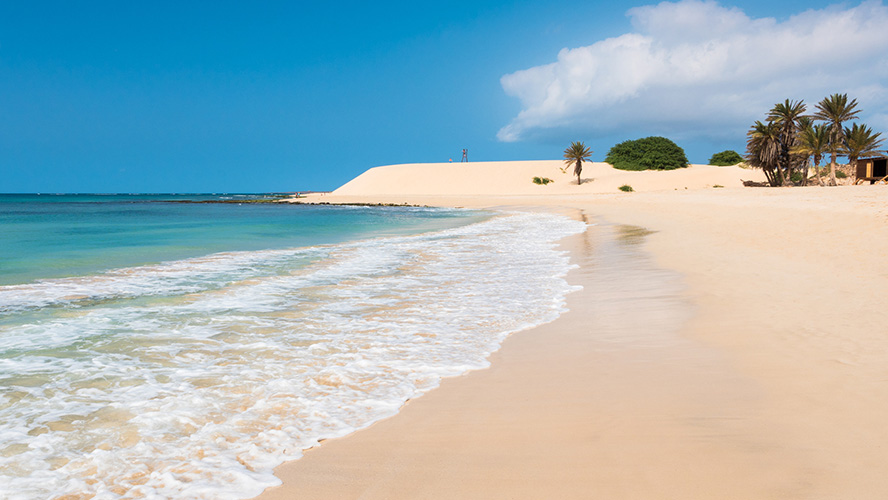
Hiking: exploring volcanic landscapes and lush tropical valleys
Hiking in Cape Verde is one of the best ways to immerse yourself in the country’s volcanic and mountainous scenery, where untamed nature exists alongside the traditional rural way of life. On the island of Santo Antão, the Vale do Paúl is one of the most emblematic routes. This green and fertile valley, surrounded by steep mountains, waterfalls and little villages, is the perfect place for visitors seeking close contact with local life. As you progress along the trail, you can discover sugar cane and coffee plantations, and orchards full of tropical fruits, all set within a landscape of deep gorges that seem to have been carved out with a knife.
Another adventure not to be missed is the climb up Pico do Fogo, Cape Verde’s highest active volcano on the island of Fogo. This is a challenge that attracts not only the most adventurous, but also those seeking the spectacular views from the summit. During the ascent, the terrain undergoes a dramatic change, from arid landscapes to fields of volcanic ash. The reward for reaching the summit is a breathtaking panorama of the caldera and the active crater, as well as the feeling of having conquered one of the Atlantic’s most iconic peaks.
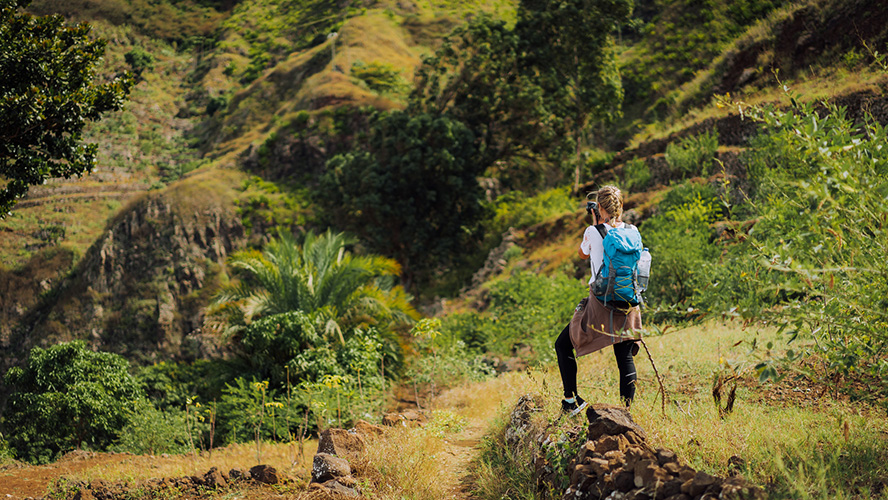
Diving: discover the undersea treasures of the islands of Sal and Boa Vista
Cape Verde is also an undersea paradise for diving enthusiasts. The crystal-clear waters and the diversity of marine life constitute an ideal setting in which to explore the secrets of the ocean. The islands of Sal and Boa Vista offer infinite options for diving. The coral reefs that surround these islands offer a vibrant spectacle of colours and shapes, where tropical fish of every imaginable hue weave in and out of underwater caves and unique rock formations. One great attraction is exploring the remains of sunken shipwrecks — witnesses to the archipelago’s maritime history.
In addition, the marine species that inhabit the waters of Cape Verde are a veritable treasure for divers. It is common to see turtles, rays and dolphins, but perhaps the most exciting thing is the possibility of seeing the sharks that patrol the waters around the islands. The diversity of the marine life is further enhanced with the seasonal arrival of humpback whales, which swim around the coast as they migrate. In a nutshell, these experiences make Cape Verde an unrivalled destination for diving enthusiasts, offering a window on to an undersea world full of wonders.
